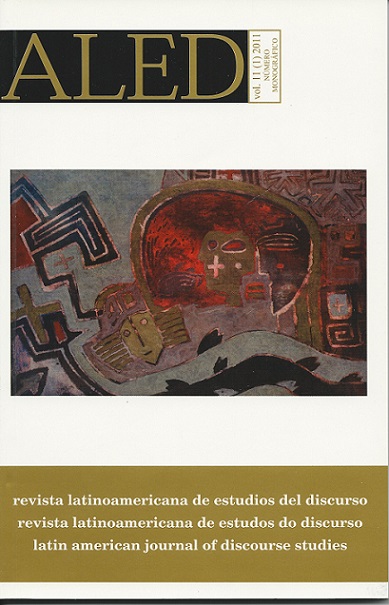Ainda o contexto
algumas considerações sobre as relações entre contexto, cognição e práticas sociais na obra de Teun van Dijk
Keywords:
context. context model. language practices. social cognition.Abstract
The aim of this paper is to make a discussion around the notion of context, focusing on the seminal work of Teun van Dijk, drawing some parallels with his postulations on this most important issue with the postulations of other authors who have dedicated themselves to reflect on this concept in relationship to language production. To this end, we tried to give an interpretation to the theoretical approach of van Dijk in the construction of the concept of context model. Finally, we tried to also present brief analytical comments on a language practice based on the discussed relations between language, context and social cognition.
Downloads
References
Agha, A. (2007). Language and social relations. New York: Cambridge University Press.
Antos, G. (1997). ‘Texte als Konstitutionsformen von Wissen. Thesen zu einer evolutionstheoretischen Begründung der Textlinguistik. In: Antos, G.; Tietz,
H. (Eds.) Die Zukunft der Textlinguistik. Traditionen, Transformationen, Trends, pp. 43-63, Tübingen: Nieneyer. Firth, J. Personality and language in society. Sociological Review, 42: 37-53, 1950.
Granato, L. B. (2011). ‘Gêneros discursivos em foco: dos Programas Manos e Minas e Altas Horas’. Campinas, SP: Instituto de Estudos da Linguagem. Dissertação de Mestrado, pp 1-325.
Goffman, E. (1974). Frame analysis. New York: Harper & Row.
Gumperz, J. (1982). Discourse strategies. Cambridge: Cambridge University Press.
Goodwin, C.; Duranti, A. (1992) Rethinking Context. Cambridge: Cambridge Universitry Press.
Hanks, W. F. (2008). ‘O que é contexto’. In: Bentes, A. C.; Rezende, R.C.; Machado, M. R. (Orgs.) Língua como prática social: das relações entre língua, cultura e sociedade a partir de Bourdieu e Bakhtin, pp. 169-203. São Paulo, Cortez.
Hymes, D. (1964). ‘Introduction: towards ethnographies of communication’. In: Hymes, D. Foundations in Sociolinguistics. Philadelphia: University of Philadelphia, 1974.
Koch, I. G. V. (2004) Introdução à linguística textual. São Paulo: Martins Fontes.
Koch, I. G. V. (2002) Desvendando os segredos do texto. São Paulo: Cortez Editora.
Malinowski, B. (1923). ‘The problem of meaning in primitive languages’. In Ogden, C. K. & Richards, I. A. (Eds.), The meaning of meaning, New York: Harvest/HBJ Books, pp. 146-152.
Marcuschi, L. A. (2001). Perplexidades e perspectivas da lingüística na virada do milênio. Texto apresentado na VI Semana de Letras. João Pessoa: UFPB
Marcuschi, L. A. (2002) ‘Do código para a cognição: o processo referencial como atividade cognitiva’. Veredas 10: 43-62.
Mondada, L; Dubois, D. (2003). ‘Construção dos objetos de discurso e categorização: uma abordagem dos processos de referenciação’. In: Cavalcante, M.M.; Rodrigues, B.B.; Ciula, A. (Orgs.) Referenciação, pp 17-52. São Paulo: Contexto.
Morato, E. M. (2010). ‘A noção de frame no contexto neurolinguístico: o que ela é capaz de explicar?’ Cadernos de Letras da UFF ”“ Dossiê: Letras e cognição, 41: 93-113.
Tannen, D.; Wallat, C. (1987). ‘Enquadres interativos e esquemas de conhecimento em interação: exemplos de um exame/consulta médica’. In: Ribeiro, B. T.; Garcez, P. M. (Orgs.) Sociolingüística Interacional, pp.70-97. Porto Alegre: AGE.
van Dijk, T. (2008). Discourse and Context: A sociocognitive approach. Cambridge: Carmbridge University Press.
van Dijk, T. (2006). ‘Discourse, context and cognition’. Discourse Studies, 8(1): 159”“177.
van Dijk, T. (1997a). ‘Cognitive context models and discourse’. In: Stamenov, M. (Ed.) Cognition and Consciousness, pp.189-226.. Amsterdam: Benjamins.
van Dijk, T. (1997b). (Ed.) Discourse as social interaction. London: Sage Publications Ltd.
van Dijk, T. (1977). Text and Context. Explorations in the semantics and pragmatics of discourse. London and New York: Longman.
Downloads
Published
How to Cite
Issue
Section
License

This work is licensed under a Creative Commons Attribution-NonCommercial-NoDerivatives 4.0 International License.
The authors retain the copyright and guarantee RALED the right to be the first publication of the work as well as a Creative Commons Attribution License that allows others to share the work with recognition of authorship and the initial publication in this journal.




